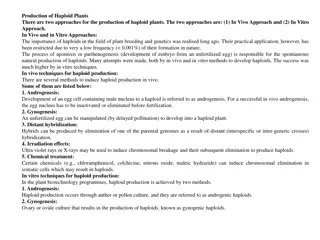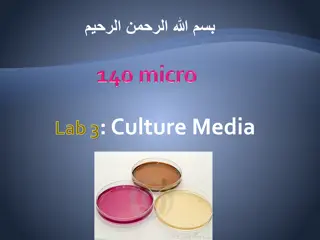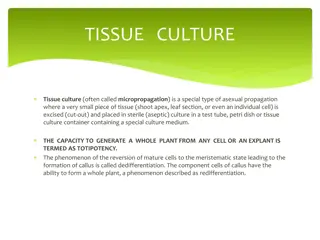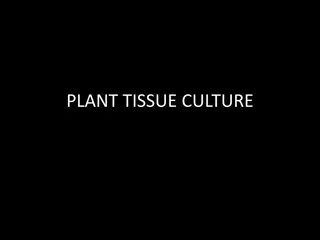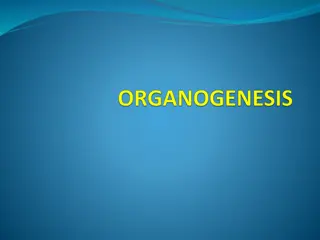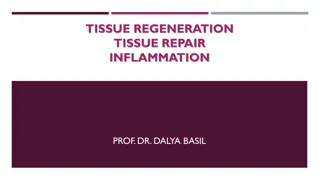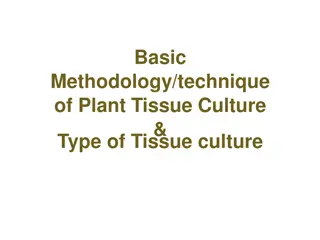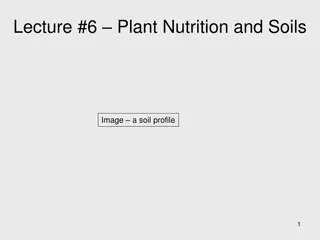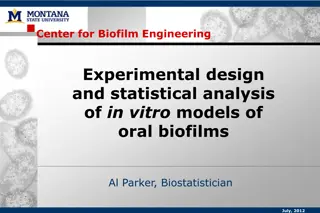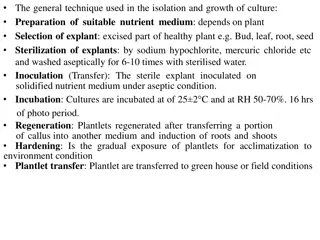Understanding Plant Tissue Culture Media and Their Importance in In Vitro Growth
Plant tissue culture media play a crucial role in the in vitro growth and morphogenesis of plant tissues. The composition of culture media depends on the specific plant species and the type of material used for culture. Various types of media, such as White's medium, MS medium, B5 medium, N6 medium, and Nitsch's medium, provide essential nutrients to support the growth of plant cultures. The success of plant tissue culture relies on selecting the right nutrient medium tailored to the specific plant requirements.
Download Presentation

Please find below an Image/Link to download the presentation.
The content on the website is provided AS IS for your information and personal use only. It may not be sold, licensed, or shared on other websites without obtaining consent from the author. Download presentation by click this link. If you encounter any issues during the download, it is possible that the publisher has removed the file from their server.
E N D
Presentation Transcript
Tissue culture media Culture media are responsible for the in vitro growth and morphogenesis of plant tissues. composition of the culture media dependent on particular species of the plant and its material used for culture eg: cell, tissue or organ Major Types of Media: White s medium, MS medium, B5 medium, N6 medium, Nitsch s medium etc. Media constituents are elements needed for plant nutrition and their physiological functions which is supplied in the culture medium to support adequate growth of cultures in vitro. culture media usually contain the following constituents: Inorganic nutrients, Carbon and energy sources, Organic supplements, Growth regulators and Solidifying agents if required.
Culture media are largely responsible for the in vitro growth and morphogenesis of plant tissues. The success of the plant tissue culture depends on the choice of the nutrient medium. In fact, the cells of most plant cells can be grown in culture media. Basically, the plant tissue culture media should contain the same nutrients as required by the whole plant. It may be noted that plants in nature can synthesize their own food material. However, plants growing in vitro are mainly heterotrophic i.e. they cannot synthesize their own food. Composition of Media: The composition of the culture media is primarily dependent on two parameters: 1. The particular species of the plant. 2. The type of material used for culture i.e. cells, tissues, organs, protoplasts. Thus, the composition of a medium is formulated considering the specific requirements of a given culture system. The media used may be solid (solid medium) or liquid (liquid medium) in nature. The selection of solid or liquid medium is dependent on the better response of a culture. Major Types of Media: The composition of the most commonly used tissue culture media is briefly described below. White s medium: This is one of the earliest plant tissue culture media developed for root culture. MS medium: Murashige and Skoog (MS) originally formulated a medium to induce organogenesis, and regeneration of plants in cultured tissues. These days, MS medium is widely used for many types of culture systems. B5 medium: Developed by Gamborg, B5 medium was originally designed for cell suspension and callus cultures. At present with certain modifications, this medium is used for protoplast culture. N6 medium: Chu formulated this medium and it is used for cereal anther culture, besides other tissue cultures. Nitsch s medium: This medium was developed by Nitsch and Nitsch and frequently used for anther cultures. Among the media referred above, MS medium is most frequently used in plant tissue culture work due to its success with several plant species and culture systems. Synthetic and natural media: When a medium is composed of chemically defined components, it is referred to as a synthetic medium. On the other hand, if a medium contains chemically undefined compounds (e.g., vegetable extract, fruit juice, plant extract), it is regarded as a natural medium. Synthetic media have almost replaced the natural media for tissue culture. Expression of concentrations in media: The concentrations of inorganic and organic constituents in culture media are usually expressed as mass values (mg/l or ppm or mg I-1). However, as per the recommendations of the International Association of Plant Physiology, the concentrations of macronutrients should be expressed as mmol/l and micronutrients as mol/l . Constituents of Media: Many elements are needed for plant nutrition and their physiological functions. Thus, these elements have to be supplied in the culture medium to support adequate growth of cultures in vitro. A selected list of the elements and their functions in
The culture media usually contain the following constituents: 1. Inorganic nutrients 2. Carbon and energy sources 3. Organic supplements 4. Growth regulators 5. Solidifying agents 6. pH of medium Inorganic Nutrients: The inorganic nutrients consist of macronutrients (concentration >0.5 mmol/l ) and micronutrients (concentration <0.5 mmol/l ). A wide range of mineral salts (elements) supply the macro- and micronutrients. The inorganic salts in water undergo dissociation and ionization. Consequently, one type of ion may be contributed by more than one salt. For instance, in MS medium, K+ ions are contributed by KNO3 and KH2PO4 while NO3 ions come from KNO3 and NH4NO3. Macronutrient elements: The six elements namely nitrogen, phosphorus, potassium, calcium, magnesium and sulfur are the essential macronutrients for tissue culture. The ideal concentration of nitrogen and potassium is around 25 mmol I-1 while for calcium, phosphorus, sulfur and magnesium, it is in the range of 1-3 mmol I . For the supply of nitrogen in the medium, nitrates and ammonium salts are together used. Carbon and Energy Sources: Plant cells and tissues in the culture medium are heterotrophic and therefore, are dependent on the external carbon for energy. Among the energy sources, sucrose is the most preferred. During the course of sterilization (by autoclaving) of the medium, sucrose gets hydrolysed to glucose and fructose. The plant cells in culture first utilize glucose and then fructose. In fact, glucose or fructose can be directly used in the culture media. It may be noted that for energy supply, glucose is as efficient as sucrose while fructose is less efficient. It is a common observation that cultures grow better on a medium with autoclaved sucrose than on a medium with filter-sterilized sucrose. This clearly indicates that the hydrolysed products of sucrose (particularly glucose) are efficient sources of energy. Direct use of fructose in the medium subjected to autoclaving, is found to be detrimental to the growth of plant cells. Besides sucrose and glucose, other carbohydrates such as lactose, maltose, galactose, raffinose, trehalose and cellobiose have been used in culture media but with a very limited success. Organic Supplements: The organic supplements include vitamins, amino acids, organic acids, organic extracts, activated charcoal and antibiotics. Vitamins: Plant cells and tissues in culture (like the natural plants) are capable of synthesizing vitamins but in suboptimal quantities, inadequate to support growth. Therefore the medium should be supplemented with vitamins to achieve good growth of cells. The vitamins added to the media include thiamine, riboflavin, niacin, pyridoxine, folic acid, pantothenic acid, biotin, ascorbic acid, myoinositol, Para amino benzoic acid and vitamin E. Amino acids: Although the cultured plant cells can synthesize amino acids to a certain extent, media supplemented with amino acids stimulate cell growth and help in establishment of cells lines. Further, organic nitrogen (in the form of amino acids such as L-glutamine, L-asparagine, L- arginine, L-cysteine) is more readily taken up than inorganic nitrogen by the plant cells. Organic acids: Addition of Krebs cycle intermediates such as citrate, malate, succinate or fumarate allow the growth of plant cells. Pyruvate also enhances the growth of cultured cells. Organic extracts: It has been a practice to supplement culture media with organic extracts such as yeast, casein hydrolysate, coconut milk, orange juice, tomato juice and potato extract. It is however, preferable to avoid the use of natural extracts due to high variations in the quality and quantity of growth promoting factors in them. In recent years, natural extracts have been replaced by specific organic compounds e.g., replacement of yeast extract by L-asparagine; replacement of fruit extracts by L-glutamine. Activated charcoal: Supplementation of the medium with activated charcoal stimulates the growth and differentiation of certain plant cells (carrot, tomato, orchids). Some toxic/inhibitory compounds (e.g. phenols) produced by cultured plants are removed (by adsorption) by activated charcoal, and this facilitates efficient cell growth in cultures. Addition of activated charcoal to certain cultures (tobacco, soybean) is found to be inhibitory, probably due to adsorption of growth stimulants such as phytohormones. Antibiotics: It is sometimes necessary to add antibiotics to the medium to prevent the growth of microorganisms. For this purpose, low concentrations of streptomycin or kanamycin are used. As far as possible, addition of antibiotics to the medium is avoided as they have an inhibitory influence on the cell growth.
Growth Regulators: Plant hormones or phytohormones are a group of natural organic compounds that promote growth, development and differentiation of plants. Four broad classes of growth regulators or hormones are used for culture of plant cells-auxins, cytokinins, gibberellins (Fig. 43.1) and abscisic acid. They promote growth, differentiation and organogenesis of plant tissues in cultures. Auxins: Auxins induce cell division, cell elongation, and formation of callus in cultures. At a low concentration, auxins promote root formation while at a high concentration callus formation occurs. Among the auxins, 2, 4-dichlorophenoxy acetic acid is most effective and is widely used in culture media. A selected list of auxins used in tissue cultures is given in table below.
Cytokinins: Chemically, cytokinins are derivatives of a purine namely adenine. These adenine derivatives are involved in cell division, shoot differentiation and somatic embryo formation. Cytokinins promote RNA synthesis and thus stimulate protein and enzyme activities in tissues. The most commonly used cytokinins are given in Table 43.3. Among the cytokinins, kinetin and benzyl-amino purine are frequently used in culture media. Ratio of auxins and cytokinins: The relative concentrations of the growth factors namely auxins and cytokinins are crucial for the morphogenesis of culture systems. When the ratio of auxins to cytokinins is high, embryogenesis, callus initiation and root initiation occur. On the other hand, for axillary and shoot proliferation, the ratio of auxins to cytokinins is low. For all practical purposes, it is considered that the formation and maintenance of callus cultures require both auxin and cytokinin, while auxin is needed for root culture and cytokinin for shoot culture. The actual concentrations of the growth regulators in culture media are variable depending on the type of tissue explant and the plant species. Gibberellins: About 20 different gibberellins have been identified as growth regulators. Of these, gibberellin A3 (GA3) is the most commonly used for tissue culture. GA3 promotes growth of cultured cells, enhances callus growth and induces dwarf plantlets to elongate. Gibberellins are capable of promoting or inhibiting tissue cultures, depending on the plant species. They usually inhibit adventitious root and shoot formation. Abscisic acid (ABA): The callus growth of cultures may be stimulated or inhibited by ABA. This largely depends on the nature of the plant species. Abscisic acid is an important growth regulation for induction of embryogenesis. Solidifying Agents: For the preparation of semisolid or solid tissue culture media, solidifying or gelling agents are required. In fact, solidifying agents extend support to tissues growing in the static conditions. Agar: Agar, a polysaccharide obtained from seaweeds, is most commonly used as a gelling agent for the following reasons. 1. It does not react with media constituents. 2. It is not digested by plant enzymes and is stable at culture temperature. Agar at a concentration of 0.5 to 1% in the medium can form a gel. Gelatin: It is used at a high concentration (10%) with a limited success. This is mainly because gelatin melts at low temperature (25 C), and consequently the gelling property is lost. Other gelling agents: Bio-gel (polyacrylamide pellets), phytagel, gelrite and purified agarose are other solidifying agents, although less frequently used. It is in fact advantageous to use synthetic gelling compounds, since they can form gels at a relatively low concentration (1.0 to 2.5 g l-1). pH of medium: The optimal pH for most tissue cultures is in the range of 5.0-6.0. The pH generally falls by 0.3-0.5 units after autoclaving. Before sterilization, pH can be adjusted to the required optimal level while preparing the medium. It is usually not necessary to use buffers for the pH maintenance of culture media. At a pH higher than 7.0 and lower than 4.5, the plant cells stop growing in cultures. If the pH falls during the plant tissue culture, then fresh medium should be prepared. In general, pH above 6.0 gives the medium hard appearance, while pH below 5.0 does not allow gelling of the medium. Preparation of Media: The general methodology for a medium preparation involves preparation of stock solutions (in the range of 10x to 10Ox concentrations) using high purity chemicals and demineralized water. The stock solutions can be stored (in glass or plastic containers) frozen and used as and when required. Most of the growth regulators are not soluble in water. They have to be dissolved in NaOH or alcohol. Dry powders in Media Preparation: The conventional procedure for media preparation is tedious and time consuming. Now a days, plant tissue culture media are commercially prepared, and are available in the market as dry powders. The requisite medium can be prepared by dissolving the powder in a glass distilled or demineralized water. Sugar, organic supplements and agar (melted) are added, pH adjusted and the medium diluted to a final volume (usually 1 litre).




